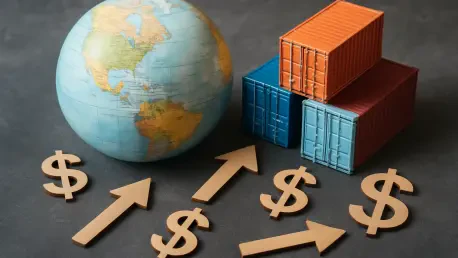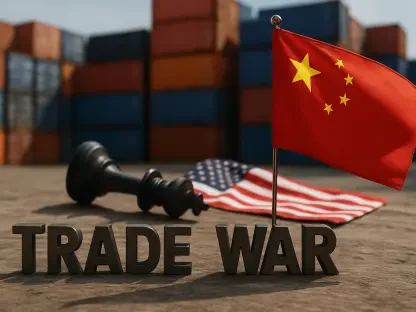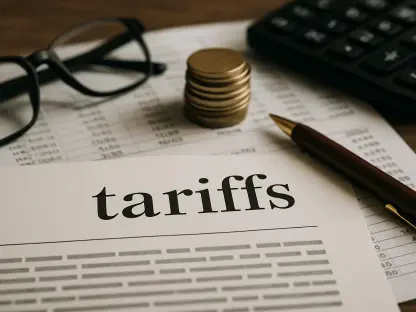The global economy is navigating turbulent waters as President Donald Trump embarks on the initial months of his second term, marked by a robust tariff strategy that has left financial markets and international trade on edge. This economic uncertainty stems from Trump’s protectionist policies aimed at shielding American industries through reciprocal tariffs, which have led to significant anxiety across global markets. The administration’s prevailing strategy underscores a decisive shift in U.S. trade policy, sparking renewed tensions with long-standing international partners.
Upon assuming office for his second term, Trump swiftly implemented an array of tariffs on numerous countries, adhering to his campaign promises. These tariffs were aimed at altering trade dynamics in favor of U.S. interests, with a temporary suspension granted to countries beyond China to allow for renegotiation. This move reignited trade tensions globally, leading to immediate effects on financial indices and commodity markets. Amidst this background, the U.S. administration made strides in trade negotiations, securing agreements with countries such as the U.K., Vietnam, and Indonesia, thereby attempting to de-escalate some of the rising tensions.
Global Trade Tensions and Economic Volatility
Surging Tariffs and Negotiation Dynamics
Trade tensions emerged prominently as Trump’s aggressive tariff policy targeted a broad range of international partners. High tariffs were imposed on imports from China, Mexico, and the European Union, among others, causing significant disruptions in global supply chains. These economic measures led to heightened volatility in financial markets, evident from the fluctuating prices of commodities and a shift in vital indicators, including oil and precious metals. The international landscape of trade negotiations transformed as countries engaged in diplomatic efforts to secure more favorable trade terms that could mitigate economic burdens.
In response to the imposed tariffs, a wave of intensive trade discussions ensued, aiming to address the resulting economic challenges. Country-specific negotiations evolved, reflecting a partial easing of tariff-induced economic distress. Noteworthy agreements, such as those secured with the U.K., Vietnam, and Indonesia, highlighted efforts to recalibrate trade relations amidst protectionist pressure. These negotiations marked a pivotal moment, with countries trying to balance domestic economic interests while reducing global tariff tensions.
Impact on Commodity and Financial Markets
The tariff-induced surge in global tensions has precipitated a significant impact on commodity markets. Trade restrictions contributed to spikes in commodity prices, from agriculture to key minerals, resulting in financial strains across industries. The oil market, specifically, was severely impacted. Concerns regarding reduced global trade activity adversely affecting demand led to a downturn in oil prices, despite transient spikes fueled by geopolitical concerns surrounding Iran. This volatile environment has led investors to seek alternative safe-haven assets, such as gold, which has seen unprecedented price levels due to rising economic uncertainty.
The financial market’s response to an unstable trade environment was visible across major indices. The Dow Jones Industrial Average, a critical indicator of corporate health in the U.S., experienced notable declines, losing a significant portion of previous gains amidst tariff tensions. Although partial recovery was noted following new trade agreements, signifying reduced market uncertainty, the fluctuations in indices like the S&P 500 and Nasdaq illustrated the pervasive volatility. The technology-driven Nasdaq index bore the brunt of these shifts due to its intensive trade-dependent nature but managed to stage a recovery as investor confidence slowly returned.
Technology Sector Resilience Amidst Tariff Pressures
Technology Giants Grappling with Economic Ripples
Technology firms, often referred to as the “Magnificent Seven,” face a challenging landscape in the wake of Trump’s tariff policies. The sector’s dependency on international supply chains and global trade agreements meant that companies like Tesla and Apple had to navigate significant market fluctuations. Tesla, in particular, experienced substantial stock price drops, shocking investors accustomed to its longstanding growth trajectory. The plummet was partly attributed to CEO Elon Musk’s public association with Trump’s campaign, which exacerbated investor concerns about the firm’s future amidst geopolitical unpredictability.
Despite these challenges, other companies in the sector showcased mixed performances. Apple and Alphabet, the parent company of Google, encountered notable, albeit less severe, declines. These companies’ robust market foundations enabled them to better withstand protectionist pressures, with recovery buoyed by the negotiation of new trade agreements. While tariff-induced uncertainty questioned operational strategies, the prospect of evolving trade dynamics offered a silver lining, allowing firms to recalibrate their approaches.
Innovation and Adaptation as Drivers
Certain technology players remained buoyed by the prevailing environment, their resilience highlighting the industry’s adaptive nature. Nvidia, a leader in artificial intelligence advancements, capitalized on continuous demand for tech innovations, witnessing a striking rise in its stock price. This uptrend was bolstered by Nvidia’s unprecedented milestone of reaching a $4 trillion market valuation amidst challenging conditions. Similarly, Microsoft’s stock experienced substantial uplifts as it continued leveraging its technological competencies, while Meta, formerly known as Facebook, witnessed commendable growth despite economic pressures.
These dynamics underscore the heterogeneous impact Trump’s tariff policies have had on the technology sector, reflecting the industry’s dual role as both a victim and beneficiary. Companies have strategically pivoted to harness emerging opportunities, focusing on innovations that promote resilience and leverage the market’s evolving landscape. In an unpredictable economic climate, the technology sector has emerged as a focal point for adaptation amidst global challenges.
Navigating the Path Forward
The Interplay of Protectionism and Global Economics
The repercussions of Trump’s aggressive tariff policy during his second term have been profound, altering the global economic landscape and deepening trade complexities. The protectionist approach underpinning these strategies further accentuates uncertainty in international markets, posing challenges to countries striving to balance domestic economic protection with global cooperation needs. As trade negotiations continue, evolving dynamics within both the U.S. and abroad are set to shape the economic environment, signaling a transitional phase marked by intricate geopolitical calculations.
Amidst volatile trade scenarios, businesses worldwide are revisiting operational strategies, prioritizing resilience through diversified supply chains and innovative practices. Adapting to these shifts requires a nuanced approach, where stakeholders recognize the primacy of open dialogues and collaborations for fostering sustainable economic growth. Despite the inherent challenges, opportunities for strategic partnerships and technological advancements continue to emerge, driven by the imperative to sustain global economic stability amidst protectionist realities.
Navigating Uncertainty with Strategic Vision
As President Donald Trump begins the initial months of his second term, the global economy faces significant challenges due to his aggressive tariff policy. His protectionist approach, focused on reciprocal tariffs to defend American industries, has shaken financial markets and international trade. This policy signifies a distinct shift in U.S. trade strategy, leading to renewed friction with traditional allies. Immediately after taking office for his second term, Trump rolled out various tariffs on several countries, fulfilling his campaign pledges. These tariffs aimed to redefine trade relations in favor of U.S. interests, with a temporary exemption given to nations other than China, allowing time for negotiations. This decision rekindled global trade tensions, impacting financial markets and commodity prices sharply. Despite the tumult, the Trump administration made progress in trade talks, finalizing deals with nations like the U.K., Vietnam, and Indonesia in efforts to reduce some of the escalating tensions and stabilize economic relations.









